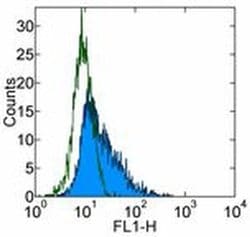Learn More
CD171 Monoclonal Antibody (eBio5G3 (5G3)), eBioscience™, Invitrogen™
Mouse Monoclonal Antibody
$1586.00 - $3925.00
Specifications
| Antigen | CD171 |
|---|---|
| Clone | eBio5G3 (5G3) |
| Concentration | 0.5 mg/mL |
| Applications | Flow Cytometry, Immunohistochemistry (Frozen), Immunoprecipitation, Western Blot |
| Classification | Monoclonal |
| Catalog Number | Mfr. No. | Quantity | Price | Quantity & Availability | |||||
|---|---|---|---|---|---|---|---|---|---|
| Catalog Number | Mfr. No. | Quantity | Price | Quantity & Availability | |||||
14-171-937

|
Invitrogen™
14171937 |
2 mg |
Each for $1,586.00
|
|
|||||
14-171-995

|
Invitrogen™
14171995 |
10 mg |
Each for $3,925.00
|

|
|||||
Description
The MAb eBio5G3 recognizes CD171 also known as neural cell adhesion molecule L1. CD171 is a member of the Ig superfamily containing 6 extracellular Ig domains and five fibronectin type III-like repeats. CD171 has been shown to function as a cell adhesion molecule mediating homotypic and heterotypic cell-cell interactions in neuronal myelination, neurite outgrowth and regeneration. Expression of CD171 has been found on monocytes and mature monocytic-derived and follicular DCs, a minor subset of lymphocytes in addition to that found on neuronal tissue and some tumor cells lines. Expression of CD171 on tumors is thought to contribute to tumor progression. Epitope of eBio5G3 is in amino-terminal Ig-like domain.
L1CAM/CD171 is an axonal glycoprotein belonging to the immunoglobulin supergene family. The ectodomain, consisting of several immunoglobulin-like domains and fibronectin-like repeats (type III), is linked via a single transmembrane sequence to a conserved cytoplasmic domain. This cell adhesion molecule plays an important role in nervous system development, including neuronal migration and differentiation. Mutations in the gene cause three X-linked neurological syndromes known by the acronym CRASH (corpus callosum hypoplasia, retardation, aphasia, spastic paraplegia and hydrocephalus). Alternative splicing of a neuron-specific exon is thought to be functionally relevant.Specifications
| CD171 | |
| 0.5 mg/mL | |
| Monoclonal | |
| Liquid | |
| RUO | |
| PBS with 0.09% sodium azide; pH 7.2 | |
| antigen identified by monoclonal antibody R1; CAML1; CD 171; CD171; CD171 molecule; HSAS; HSAS1; Hyd; L1; L1 cell adhesion molecule; L1CAM; MASA; MIC5; N-CAM L1; NCAML1; N-CAML1; N-CAM-L1; NCAM-L1; Nerve-growth factor-inducible large external glycoprotein; neural cell adhesion molecule L1; NILE; S10; sCD171; sL1 CAM; sL1CAM; soluble CD 171; soluble CD171; soluble L1 CAM; soluble L1CAM; SPG1 | |
| L1CAM | |
| Primary | |
| 4°C | |
| L1CAM |
| eBio5G3 (5G3) | |
| Flow Cytometry, Immunohistochemistry (Frozen), Immunoprecipitation, Western Blot | |
| Unconjugated | |
| Mouse | |
| Human | |
| P32004 | |
| 3897 | |
| IgG2a | |
| Affinity Chromatography | |
| Antibody |
The Fisher Scientific Encompass Program offers items which are not part of our distribution portfolio. These products typically do not have pictures or detailed descriptions. However, we are committed to improving your shopping experience. Please use the form below to provide feedback related to the content on this product.
